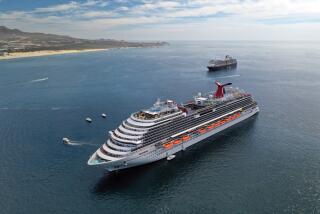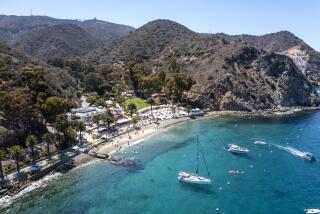Going to a Corner Somewhere--Maybe in Greece
- Share via
AMORGOS, Greece — The sea crashed turquoise onto a bank of bleached, coarse sand in the dazzling light of the Libyan Sea.
As we waited there on the south shore of Crete, a German man began to conjure images of other islands I might like. Naxos was one. He said it is a green island, so many Germans like to go there to walk.
Not stopping to think that walk to most Germans would mean hike to me, I thought Naxos called for a visit. So in a roundabout way I arrived at Naxos, but it was Amorgos that lured me on.
I dragged my suitcase out from where I’d stashed it behind a sandwich board announcing ferry schedules, lugged it down the pier and climbed aboard Skapolitus, one of the smaller ferries that makes regular rounds to its own select group of islands.
The ferry transports the likes of mail, produce, motorbikes, mattresses, locals and vacationers--providing the wind and seas (we might call them gods) are amenable.
I always enjoy the freedom of being off in some corner of somewhere without anyone knowing where I am. Being out on the Aegean adds another dimension to that feeling. In Greece the sensations are intense--hot sun, scintillating, blue sea, silken breezes and blinding light.
Dry and Barren
Skapolitus stopped at a couple of pile-of-rocks islands hardly mentioned in my guidebook. Dry and barren (“but sandy,” said one Scandinavian backpacker with a twinkle in his eye). Out of the hold came cases and cases of orange soda and mineral water, crates of vegetables, sacks of flour and relatives returning home.
As merchants peeled off bills--cash on the barrel head--and the crew checked off payment, 4-year-olds jumped up and down and giggled as they hugged and kissed friends.
In 10 minutes we were on our way again, golden sun slipping lower in the sky and evening mist transforming the blue to pale violet and mauve. As darkness fell we chugged into Katapola, the larger port of Amorgos. We spilled off of Skapolitus right into the center of town.
A couple of small tavernas with outside tables and several shops selling produce and basic provisions run along this wharf-street. Houses on narrow stone walks meander up the hills behind.
I could see the sparkle of a few lights scattered around the bay and another cluster under the hill on the other side. Mountains rise straight up in a horseshoe around the water, dark and glistening in the night, reflecting patches of light.
In the darkness we were greeted by women and young girls asking, “You want room?” I answered one, “Yes,” and joined her in a long walk toward the lights in the distance. I was happy when she grabbed one of the handles of my suitcase to help carry it.
Dockside Arrangements
But dockside agreements, as good as they might sound, are not always the most satisfactory. The girl delivered me to a fishwife who seemed to be some relative of hers. She gave me the choice of two rooms upstairs. I chose the front one because it had windows on two walls and I thought the cross-ventilation would freshen the air.
I opened the front windows--to the chatter and clatter of people eating and the smell of fish grilling below.
The next morning it took me only moments to find a more appealing room, one with its own bathroom and solar-heated water.
Amorgos has one hotel, on the far end of the island where they installed electricity just in the last year or so; it’s a five-hour walk or a ferry ride away from Katapola. But off-season travelers can easily find rooms in pensions or private homes in Katapola or up in Chora.
Visitors to Greece speak a variety of languages, and because of this many of the householders and taverna keepers, even in Amorgos, speak some English. Nevertheless, a word or two of Greek goes miles in communicating with these independent, hard-working and friendly people.
Twice a day a rickety bus leaves Katapola and rattles up to Chora, a whitewashed town atop the mountain (two hours by foot) and rambles down and around to Hozoviotissa and Agia Anna below. Here the green and blue sea is confronted by a sheer cliff rising sharply from the depths, and there, plastered high into the cliffside, is the monastery of Hozoviotissa.
Brilliant white, it gleams steady like a beacon, suspended in time and space over the blue far below. The path leading up to the monastery, now inhabited by only two monks, is laid in stone and protected by a low stone wall.
The bus announces its last trip back by honking from its appointed stop above. Sunbathers scramble into their clothes and up the stony precipice in a hurry to greet it. Packed to almost overflowing, the bus shudders up and down the dirt road, around treacherous curves. Happy souls disembark at Chora and the rest bounce on down to Katapola.
The moon had waned, so there would be fresh fish tonight, maybe even lobster. That morning I’d seen a woman running along the wharf with a large persimmon crayfish in hand. There are always typical Greek dishes--cucumber and yogurt, salads and various combinations of feta cheese, eggplant, tomato, potato, macaroni and lamb, but rarely little delicacies such as stuffed grape leaves and spinach pie.
Dinner with a Scot from Athens who teaches English and loves to speak it for a change. A little wine with the American who sailed in on the yacht from San Francisco flying a huge American flag; four years out, he loves to drink and talk with the locals, especially the owner of the caique that took us to swim across the bay.
But perhaps I would end this night with my friends from Athens, sharing soft conversation melded with a little English, a little Greek and a little French.
-- -- --
As a general rule you can fly from Athens to almost any island with an airport for $15 to $25. Ferries cost about half as much (more or less depending upon whether you stop at islands en route or go directly to your farthest destination). Ferries are the only public transportation to many islands.
I found that failing to make flight reservations posed no problem other than the anxiety of waiting to get on a flight from the standby list. But I always got on my flights, even on the day when every Greek was flying somewhere to be in his hometown to vote.
If you’re a nervous mover or can’t stand not knowing what you’re going to do, take a bus downtown and spend some time at the Archeological Museum (it’s worth the trip to Athens) or go catch a ferry. Ferries leave the port of Piraeus every day for almost everywhere. If it’s an overnight trip, get a cabin or be prepared for a chilly night on deck.
The route I took to Amorgos originated in Athens and progressed to Crete, Santorini, Naxos, Amorgos and returned to Athens via Mykonos.
I stayed most often in rooms in homes or guest houses with bathrooms down the hall or in small hotels with interior baths. There are signs (and people) all over advertising “Rooms to Let.” The cost per room was usually 800 to 1,000 drachmas a night ($6 to $7.50). The rooms accommodate two people and cost the same whether for one or two. The “hotel” in Apollonas cost 600 drachmas a night, half the usual fare.
My luxury stint in the Heraklion (Crete) Xenia Hotel, which included a large room with a balcony overlooking the sea, a beautiful bathroom with unlimited hot water and huge towels, a swimming pool and a complete breakfast, ran 2,000 drachmas a night. By the end of June, rates go up about 50%.
Eating Cheaply
Eating costs 500 to 1,000 drachmas a day, a little less on Amorgos and more on Mykonos. It is possible to spend even less if you buy food--fruit, vegetables, bread, yogurt, cheese--from the town shops. Soft drinks and beer cost almost as much as food; drinking water throughout the islands is delicious and cheap.
The bus ride from Naxos town to Apollonas cost 180 drachmas ($1.35). It leaves from the center of town by the bay.
Quite a few rooms are available in this rustic town for the usual 800 to 1,000 drachma rate; some are lovely, others only tolerable. Just inland there are terrific, thick bamboo windbreaks that sigh loudly as the wind blows through.
The round-trip fare from Katapola to Hozoviotissa/Agia Anna via Chora on Amorgos cost 40 drachmas (30 cents). Most islands also have motor scooter rentals for $5 to $10 a day.
Amorgos, so far, has been spared the drone and screeching of rental cars. Wait for the bus or caique or take a walk. And watch the clouds as they roll along overhead and the sea glints back the sunshine.
For more information, contact Greek National Tourist Office, 611 West 6th St., Suite 1998, Los Angeles 90017, phone (213) 626-6696.
More to Read
Sign up for The Wild
We’ll help you find the best places to hike, bike and run, as well as the perfect silent spots for meditation and yoga.
You may occasionally receive promotional content from the Los Angeles Times.






